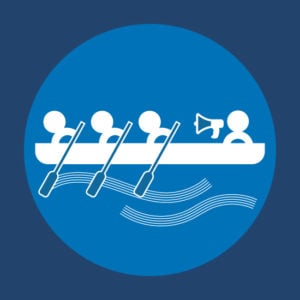When we’re talking how to successfully scale Agile in your Organization, having a clear picture of your Organization’s Governance is key. We discuss Governance at length in our Scaling white paper. (By the way, if you haven’t downloaded Scaling, we highly recommend it.) Here’s an excerpt:
The scaled Organization’s Governance – its actual decision-making process – could be hard to see. We hope that the sub-Teams are communicating and working together somehow, but it may not be obvious exactly how they’re doing it – it may be that their actual decision-makers are not their formal leadership. In real life, an Organization’s Governance can be formal, informal, or even stealth – an Organization’s overall Governance is often part of its Culture, not its official Process.
So, to successfully scale, you first have to put on your detective hat and determine how decisions are truly being made within your Organization. You need to dig deep and figure out your Organization’s alignment. In many Organizations, there are two distinct alignment styles. Failing to understand and correctly navigate your Organization’s alignment style is why scaling so often flounders.
‘Top-To-Bottom’ Alignment
 If your Organization’s alignment is top-to-bottom, it should resemble that of a rowing team, with the coxswain (Big Boss) sitting in the boat’s stern, anticipating, coordinating and guiding the rowers’ (workers) synchronized strokes that propel the boat across the water. For the boat to move smoothly and swiftly, the coxswain and the rowers must be in sync, with every rower stroking in the same direction. In the same way, everyone in the Organization must be pulling in the same direction and on the same page about what is being delivered to Stakeholders. What the Big Boss thinks should be developed and the workers’ reality about what is being developed must be in sync. This is alignment on the what, why and when of development. This is what top-to-bottom alignment should look like.
If your Organization’s alignment is top-to-bottom, it should resemble that of a rowing team, with the coxswain (Big Boss) sitting in the boat’s stern, anticipating, coordinating and guiding the rowers’ (workers) synchronized strokes that propel the boat across the water. For the boat to move smoothly and swiftly, the coxswain and the rowers must be in sync, with every rower stroking in the same direction. In the same way, everyone in the Organization must be pulling in the same direction and on the same page about what is being delivered to Stakeholders. What the Big Boss thinks should be developed and the workers’ reality about what is being developed must be in sync. This is alignment on the what, why and when of development. This is what top-to-bottom alignment should look like.
But that style of alignment comes with its challenges. The larger the Organization, the more difficult this alignment is to achieve. It doesn’t take a big stretch of the imagination to realize there could be huge discrepancies in information – what the Big Boss knows and what the workers know. These differences in information travel up and down through multiple levels of the Organization and mid-level decision-makers. What the workers know needs to be integrated as it travels up to the Big Boss. At the same time, the Big Boss’ intent needs to be fleshed out as it travels down to the workers. That’s a lot of information and a lot of movement, making it very easy for this top-to-bottom alignment to quickly get out of sync.
‘Left-To-Right’ Alignment
 Let’s not forget there are other alignment issues to consider, beyond top-to-bottom. There are the workers themselves. The workers all need to work together, both within and across the Organization’s sub-Teams, to deliver the expected Results. This is called left-to-right alignment, it is an alignment of the how, who, and possibly the where of development. Within the sub-Teams, left-to-right alignment becomes an issue of cooperating, coordinating and collaborating to resolve any development-related issues and dependencies that may occur. Like top-to-bottom alignment, getting left-to-right alignment down is also critical to your Organization’s scaling success.
Let’s not forget there are other alignment issues to consider, beyond top-to-bottom. There are the workers themselves. The workers all need to work together, both within and across the Organization’s sub-Teams, to deliver the expected Results. This is called left-to-right alignment, it is an alignment of the how, who, and possibly the where of development. Within the sub-Teams, left-to-right alignment becomes an issue of cooperating, coordinating and collaborating to resolve any development-related issues and dependencies that may occur. Like top-to-bottom alignment, getting left-to-right alignment down is also critical to your Organization’s scaling success.
Where to Start
So, now what? A great starting point is to determine if the communications and decision-making mechanisms are in place to enable both the top-to-bottom and left-to-right alignments to succeed. How do you do that? Start by asking the question, “Are the right people having the right conversations at the right time?”
Become a Certified Agile Scaling Professional
Are you facing the challenges of getting the right people to have the right conversations at the right time? Are you wondering what other illuminating questions you should be asking to scale Agile within your Organization?
Our Agile Scaling Professional (ASP) training delivers more in-depth, real-world training on how to tackle the difficult, yet rewarding job of Agile scaling. ASP offers two days of experiential learning that you can take back to your Organization, put into action, and get results.
As Always, Stay Agile.

